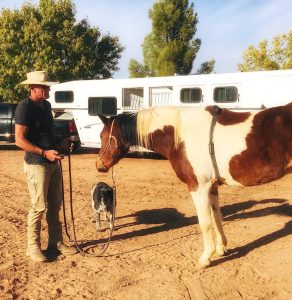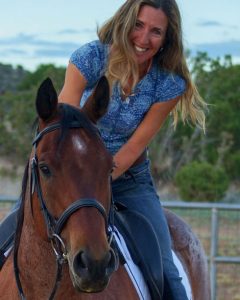
HRV is the root mean square of the difference between heart beats
Editor’s Note: As new devices like heart monitors become available for horse owners and riders, we think it’s important to understand their potentials and limitations. Technology often outpaces our knowledge base, making the setting ripe for misinterpretation and misinformation. Take a moment to educate yourself and have fun in the process. Connecting with horses may be facilitated by a device, but it’s always about taking time and being present.
Folks have been using heart rate [HR] monitors since they were clunky chest devices with thick, uncomfortable black straps. Wearing one made you feel like a hospital patient. As HR monitors have improved to slender iWatches and FitBits, it’s become easier and easier to check your pulse whenever and wherever you want.
Heart rate is a simple and important indicator of fitness and wellness. Most athletes have a low resting heart rate. Their pulse may ramp up when they exercise, but soon afterwards it will slow. Through conditioning, athletes’ hearts have become more efficient than non-athletes at pumping blood.

BHPS presenter West Taylor works with a mustang and a HRV device
More recent is the development of HR monitors for animals. For a price, you can monitor your horse’s heart rate with your phone. Monitoring heart rate and respiration can be helpful for training and conditioning.
More recent still is the advent of Heart Rate Variability [HRV] monitoring. Heart Rate Variability is what is sounds like: the amount a heartbeat varies over the course of many beats. You might think that if your HR is 60 beats a minute, then your heart is making one beat per second. In fact, it might be .97 seconds, followed by 1.01 second, followed by .99 seconds. HRV measures this variation.
HRV, researchers have found, is regulated by the autonomic nervous system [ANS], the primitive brain feature and something we share with our equine partners. Nearly all animals have a system of flight-or-fight and of relaxation; that’s the ANS in a nutshell. As Dr. Virgil DiBiase says, “The autonomic nervous system functions near the border of mind and body. Heart Rate Variability quantifies our ANS,” said DiBiase, a neurologist and long-time Best Horse Practices Summit attendee.

Broadly speaking, it’s good to have a low heart rate and a high HRV
Read more about the ANS here and here.
As a reliable indicator of activity in the autonomic nervous system, HRV can help measure our wellness and well-being. Broadly speaking, if your HRV rating is low, you may be more stressed or fatigued as your ANS may be in more of a flight-or-fight (sympathetic) mode. Low HRV rates are associated with lower survival rates from heart attacks. People with anxiety and post-traumatic stress disorders are also more likely to have low HRV readings. Learn more here.
If your HRV is high, your ANS may be in more of a relaxed (parasympathetic) state. The high HRV might indicate resilience and readiness. Physical and mental fitness both contribute to preferable HRV readings.
For human patients, HRV scores are often calculated with an electro-cardiogram [ECG] machine over a 24-hour period. Using this method, clinicians have found that low HRV can be associated with depression, anxiety, and poor overall health while patients with higher HRV readings tend to have better cardiovascular fitness and respond more resiliently to stressors.
As this author wrote: If one is in a more relaxed state, the variation between beats [HRV] is high. In other words, the healthier the ANS the faster you are able to switch gears, showing more resilience and flexibility.
Dr. Andrew Flatt, an HRV researcher and professor at Georgia Southern University. His work focuses on monitoring athletes over the course of days and weeks. He adds:
HRV will not be able to tell you precisely what the issue is, but it’s a useful indicator that something is up, and intervention may be needed.
 Katrin Silva is a regular guest columnist, a Best Horse Practices Summit presenter, and competitive ultrarunner. She considers her resting HR for training feedback and relies less on HRV. “When my heart rate jumps up ten beats at resting, I know it’s time to take it easy for a day or two. Maybe I need to recover from a hard run, or maybe I’m stressed, or maybe I’m fighting some respiratory bug. Or, all of the above.
Katrin Silva is a regular guest columnist, a Best Horse Practices Summit presenter, and competitive ultrarunner. She considers her resting HR for training feedback and relies less on HRV. “When my heart rate jumps up ten beats at resting, I know it’s time to take it easy for a day or two. Maybe I need to recover from a hard run, or maybe I’m stressed, or maybe I’m fighting some respiratory bug. Or, all of the above.
My watch uses HRV to calculate stress levels and training status…When my watch says I’m stressed, it’s generally true.”
Watch her Summit videos here and here.
HRV is complicated
You know things are complicated when mindfulness and athleticism each contribute significantly to how your heart rate is varying. Researchers try to account for the variables intrinsic to our lives and routines and how they feed into a deceivingly simple two-digit reading (average scores are between 40-70).
Horse-related HRV research is slim, but racetrack veterinarian Dr. Christine Ross has found that low HRV readings were a strong indicator of an upcoming injury or breakdown in racing thoroughbreds. Racehorse trainer Graham Motion was onto something when he said, nearly a decade ago, “a relaxed horse is a fast horse.” Read more about that in Part II.
- Can HRV monitors help us discern between training and overtraining?
- Can HRV detect the difference between feeling excited but not anxious, and feeling anxious and dread?
Maybe. We learn more every day. Read this post on interpreting HRV metrics.
Heart Math has been working with heart rate variability for over twenty five years. They’ve also done research with horses you can read about in this article from 2007. http://horseconnection.com/heart-to-heart-a-quantitative-approach-to-measuring-the-emotional-bond-between-horses-and-humans-august-2007/
Heart rate variability resilience can be trained and high risk positions, like Navy Seals for example train this ability to maintain under severe stress. Training resilience is something I’ve been doing with my freaky Sulphur mare to help her recover from trauma and increase thresholds.